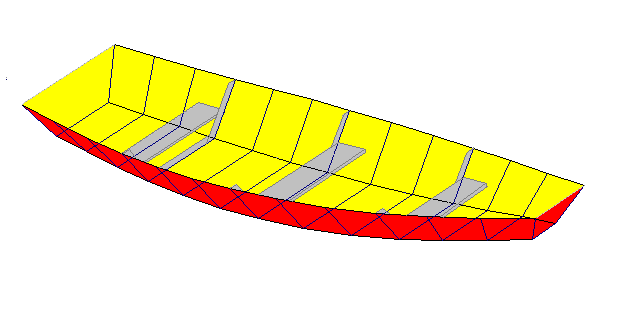14' Rowing Punt
In the summer of 2005 I visited a small boat museum in Korppoo.
An island roughly the farthest away You can get by car in the
Finnish South-Western archipelago. Using two separate
ferry connections, though.
Now with
Google Earth being there, You can easily spot the museum
at approximately 60-09-32.94 N, 21-32-30.03 E ;-)
 |
Korppoo boat museum and the retired fire chief, who runs
all practical affairs for the museum.
The museum is located in an old barn.
|
 |
Outside the museum lies an old fishing boat. The boat
is in such a condition that it might be difficult to get her
inside in one piece.
|
 |
An interesting detail of the boat. Some old boatbuilder had never
heart about distributing plank butt joints along the
length of the boat.
Well... theory is theory, plank lengths are what they happen to be.
Everything doesn't need to be perfect, and things still work ;-)
Of course someone might arue, that had the joints been distributed, the boat
would still be running :-)
And come to think of it. Distributing the joints would be like saying
"my joints are weaker than the plank". Who would admit that? The correct
"heads high"
attitude is, of course, "my joints are stronger than the plank, so I can
place them as I please" ;-)
Probably better to be safe than sorry, regardless of the attitude. So
do distribute the joints.
|
But that was not what I was going to write about.
Instead, let's go inside the museum.
 |
There are three or four pram type boats inside the museum. All boats have
been taken in straight out of service. Just cleaned, but no restoration
whatsoever has been carried out on them.
The prams are very much alike to what is generally known as
Norwegian pram. But not quite.
These prams have much less rocker.
|
 |
As You can see, the sheerline of this larger pram is nearly flat, and not
much rocker to the bottom either.
How come this difference?
Probably the deeper rocker of the Norwegian prams is more suited to the rough
conditions of the Atlantic coast, whereas a lesser amount of rocker is at
home in the more protected waters of the Baltic
sea archipelago.
In any case it should be clear that, given protected waters, too much rocker
gives You a blunt boat with short waterline. That is, a slow, hard to row
boat.
Notice something else? These prams don't have stern nor bow seats.
These prams have been strictly working boats. Fishing within a rowing range from
home, most probably. There has been no need for "sundeck seats" for idle
passengers. Only seating for the active fishing crew of one or two.
And that seating where it gives the best balance - in the middle of the boat.
|
If You come to think of it, a flat bottomed punt is a simplification of a pram.
Instead of a round shape created by using some half a dozen planks per side,
as in a pram, a flat bottomed punt has a cross sectional shape only approximating the
round shape crudely, made with only one plank per side (plus the bottom plank,
of course).
Here's a flat bottomed 14 ft rowing punt designed in line with the ideas from
the old prams in the museum. A punt, to be easier to build than a pram, but not
inferior in other aspects.

As far as the punt to pram analogy is concerned, the
Chapman Ekstock discussed
already here could be taken as a punt-simplification of a Norwegian style pram.
And take this 14 ft rowing punt as a simplification of the museum prams.
Compare the underwater volume distributions of the two punts at equal displacements,
750 lbs in this case.
The Chapman punt, with more rocker, drawn in blue, this 14 ft rowing punt, with less
rocker, in black.

It is quite evident, that the less rockered punt gives a more steamlined underbody,
and thus a more pleasant rowing experience. In reasonably protected waters, mind You.
All the plywood parts of this rowing punt can be cut out of thee sheets of 1/4" or 3/8"
plywood. Using four sheets would, however, make parts placement a lot easier. The sides
out of two sheets, the bottom and transoms out of the other two.

The metric measurements for a side. The frames made out of plank go to the positions
shown by the lines A, B and C.


Measurements for the bow and stern transoms.


Plank frames, that will stay in place in the completed punt. The three seats will
be supported by a cross plank at each frame, the top of the cross plank at the
height given here.


The placement of the rear seat is on the stern side of the frame, the placement of both
the middle and front seat is on the bow side of the frame.
And finally, here's the .hul file
for this rowing punt for those
interested.

The building sequence follows the general lines given in the instructions
on the
Portuquese
Style Dinghy.
First scraph joint the plywood for sides, cut the sides and transoms.
Make the frames out of plank.
Connect the sides to the bow transom, spring the sides around the frames,
and connect the ends of the sides to the stern transom.
Mark the bottom using the outline of the now assembled sides. Cut and attach
the bottom.
Attach seats, quarter knees, rubrails at the gunwale and transoms.
Paint the boat.
Pack Your fishing gear, put on Your life vest, and go fishing :-)
Top of the page.
Back to main page.









